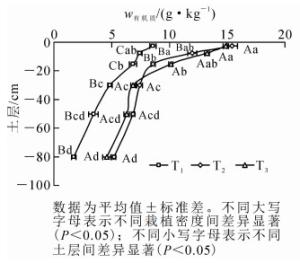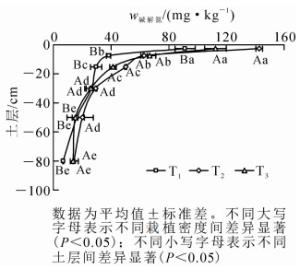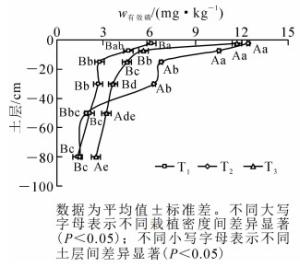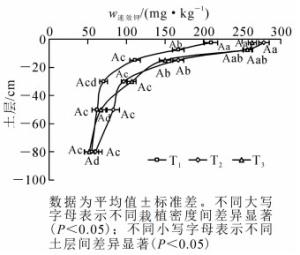-
土壤是森林生态系统的重要组成成分[1],也是维持林木健康生长的必要基质,其养分含量大小直接影响林木生长速度和质量[2]。在林地中由于养分输入、输出以及林木自身养分循环而表现出明显的垂直分布特征,且因养分类型不同具有显著差异[3],这种异质性影响整个生物学和生态学过程[4]。有关垂直方向养分的研究一般将土层划分为0~20、20~40、40~60和60~100 cm等4个层次[5],表土层作为整个土体的最上面,养分含量大小对林木生长和评价土壤肥力状况更有代表性,忽略对表土层更细致的研究,不利于精准地描述土壤养分垂直分布格局。栽植密度是营林措施中一项重要且容易操作的措施,密度大小不仅影响林分结构[6]、树冠大小[7]及各器官养分含量[8],进而影响林木对土壤养分的吸收[9];还会影响凋落物生物量及分解速率[10],最终对土壤养分状况产生深刻影响。很多学者对栽植密度与土壤养分含量之间的关系开展了研究[11-12]。有研究表明:马尾松Pinus massoniana林地土壤养分含量随密度增大而降低[13]。不同学者研究结论不尽相同,可能是由于研究对象、栽植密度及林龄不同所造成的。预计到2050年,人工林将提供75%的工业木材,其中50%由速生丰产林提供[14-15]。杨树Populus在中国的栽植面积已达850万hm2[16]。毛白杨Populus tomentosa适应性较强,具有扩大引栽栽培范围的潜力[17],S86品种相对于其他品种有较高的木材量[18]。目前,关于栽植密度对毛白杨S86的影响大多数为地上部分的研究[19]。人工林具有速生、短轮伐期、长期单一化栽植等特点,地力容易出现单一化问题[9]。为此,本研究以10年生毛白杨S86为研究对象,比较3种栽植密度林地土壤6个土层(0~5,5~10,10~20,20~40,40~60和60~100 cm)的养分情况,阐明在不同栽植密度下毛白杨土壤养分的差异情况,为人工林林地土壤的管理及施肥提供有效指导。
-
试验地位于河北省威县苗圃场。该地属于华北平原中部,地势平坦,海拔30~50 m。年均气温为13.0 ℃,最低气温在1月,为-2.5 ℃,最高气温在7月,为27.0 ℃。气候为暖温带大陆性半干旱季风气候,全年日照总时数为2 574.8 h,无霜期198.0 d,平均降水量为497.7 mm,降水主要集中在7-8月。
-
选择三倍体毛白杨无性系S86为试验材料,于2007年4月挑选长势大致相同的2年生毛白杨无性系幼苗(平均胸径为6.1 cm,树高为5.8 m)进行造林,栽植毛白杨时林地土壤养分概况为:有机质8.60 g·kg-1,全氮0.58 g·kg-1,碱解氮87.8 mg·kg-1,有效磷8.1 mg·kg-1,速效钾90.0 mg·kg-1,总孔隙度46.7%,田间持水量为26%。采用单因素完全随机设计。栽植密度3个水平(行距×株距),分别为2 m × 2 m(T1)、4 m × 3 m(T2)、4 m × 5 m(T3)。T1每行11株,T2每行7株,T3每行4株,分别为2行,3次重复共9个小区。小区以南北走向为长,东西走向为宽,保护行的栽植密度为4 m × 3 m,设置2行。表 1为2016年3种栽植密度下毛白杨生长状况统计。
表 1 3种栽植密度下毛白杨S86生长状况
Table 1. Growth status of P. tomentosa S86 under three different planting densities
栽植密度(行距×株距) 树高/m 胸径/cm 蓄积量/(m3.hm-2) 凋落物量/(3hm-2) T1(2 m × 2 m) 14.60 ± 0.25 c 12.10 ± 0.31 b 157.97 ± 7.78 a 0.69 ± 0.14 b T2(4 m × 3 m) 18.08 ± 0.12 b 13.80 ± 0.24 a 86.80 ± 12.65 b 0.74 ± 0.18 a T3(4 m × 5 m) 21.04 ± 0.35 a 13.90 ± 0.13 a 64.75 ± 11.82 c 0.79 ± 0.04 a 说明:同列不同小写字母表示不同栽植密度毛白杨生长状况差异显著(P<0.05) -
2016年11月中旬收集土样,随机选取试验小区中央位置的5株树木,在其东侧80 cm处定点取样。先剥开凋落物,用土钻分别取(0~5、5~10、10~20、20~40、40~60和60~100 cm)6个土层土壤样品,将每个小区5个取样点土层的40~60和60~100 cm的2个土层的5个土样分别混为1个样品,土层0~5、5~10、10~20和20~40 cm土样不混合。
另采集3种栽植密度的凋落物,具体方法为每个小区取5个面积为60 cm × 60 cm凋落物样点,烘干称量得凋落物质量(表 1)。样品经室内风干、研磨、过筛后测定土壤养分。有机质采用重铬酸钾外加热法,碱解氮采用扩散法,有效磷采用钼锑抗比色法,速效钾采用火焰光度计法测定[20]。
-
采用Excel 2010计算和整理数据并进行图表绘制。数据间的方差分析(one-way ANOVA)、多重比较(Ducan检验法)采用SPSS 20.0进行分析。
-
10年生毛白杨S86林地土层养分所占比例随土层深度增加而减少,从土层0~20 cm占整个土层的69%~79%减少到60~100 cm土层仅占4%~7%(图 1)。养分所占比例在0~5、5~10和10~20 cm有一定的区别,特别是碱解氮在3个土层间有明显差异,0~5 cm土层所占比例高达41%~45%。

图 1 图 1常量元素迁移率随土壤剖面的变化图
Figure 1. Variation of constant element with soil profile
-
3种栽植密度的毛白杨S86林地土壤有机质质量分数分别为1.72~8.57 g·kg-1(T1)、5.20~15.44 g·kg-1(T2)、4.58~14.86 g·kg-1(T3),且随土层深度的增加而减少(图 2)。0~5,5~10和10~20 cm有机质质量分数随土层变化较为缓慢,20~40,40~60和60~100 cm随土层增加下降较明显。方差分析显示:土层深度对有机质质量分数有显著影响(P < 0.05),0~5和5~10 cm土层有机质质量分数差异不显著,但均显著高于其他土层,10~20、20~40和60~100 cm之间有机质质量分数差异显著(P < 0.05)。有机质质量分数随栽植密度和土层变化而变化。0~5、20~40、40~60和60~100 cm土层,有机质质量分数从大到小依次为T2、T3、T1,0~5 cm土层,T2和T3有机质质量分数分别较T1增加80.16%和73.40%;5~10和10~20 cm土层,有机质质量分数从大到小依次为T3、T2、T1(图 2)。总的来说,T1有机质质量分数显著低于T2和T3。
-
毛白杨S86林地碱解氮质量分数为6.8~142.7 mg·kg-1(图 3),随土层深度的增加而减少。土层对碱解氮质量分数影响显著(P < 0.05),各土层之间(除60~100 cm)差异显著(P < 0.05)。3种栽植密度下碱解氮质量分数在0~5、10~20、20~40、40~60和60~100 cm土层从大到小依次为T2、T3、T1(图 3);碱解氮质量分数在5~10 cm土层从大到小依次为T3、T2、T1。随土层深度增加,不同栽植密度间碱解氮质量分数差异越来越小,可能由于冬季淋溶作用较弱的原因所导致。
-
3种栽植密度的毛白杨S86林地土壤有效磷质量分数分别为1.3~6.1 mg·kg-1(T1)、1.5~12.4 mg·kg-1(T2)和2.5~11.7 mg·kg-1(T3),随土层深度增加,有效磷质量分数呈下降趋势(图 4),从0~5 cm土层占整个土层的31%~37%减少到60~100 cm土层仅占4%~8%(图 1)。栽植密度对有效磷质量分数影响显著(P < 0.05)。0~5 cm土层有效磷质量分数大小依次为:T2(12.4 mg·kg-1)、T3(11.7 mg·kg-1)、T1(6.1 mg·kg-1),T1显著低于T2和T3。有效磷质量分数在土层5~10、10~20和20~40 cm表现为3条有差异的曲线(图 4)。多重比较结果表明:T2显著高于T1和T3,T1和T3差异不显著;40~100 cm土层T3显著高于T1和T2(P < 0.05)。
-
速效钾质量分数随土层增加呈下降趋势(图 5)。5~10 cm土层速效钾质量分数显著高于10~20 cm(P < 0.05),与0~5 cm土层差异不显著,20~40、40~60和60~100 cm土层间速效钾质量分数差异不显著。T2的土壤速效钾质量分数最高,为60.3~278.1 mg·kg-1。T1速效钾质量分数小于T2和T3(图 5)。方差分析表明:栽植密度对土壤速效钾质量分数无显著影响(P>0.05)。
-
10 a后毛白杨S86林地土壤养分质量分数发生变化,碱解氮和有效磷降低,栽植密度越大降低的程度越明显,特别是碱解氮,在T1处理下降低了60%(表 2)。表明随林龄增加,毛白杨从土壤中吸收越来越多的氮素来供地上部分生长,从而导致土壤氮库储量和供氮能力的下降。
表 2 10 a前后毛白杨S86林地土壤养分质量分数
Table 2. Soil nutrient (mean) content in P. tomentosa S86 stand before and after 10 years
年份 处 w有机质/(g.kg-1) w碱解氮/(mg.kg-1) w有效磷/(mg.kg-1) w速效钾/(mg.kg-1) 2016 T1 5.5 ± 0.1 c 34.8 ± 0.1c 3.3 ± 0.1 c 113.0 ± 0.1a T2 9.2 ± 0.1 a 53.3 ± 0.1b 6.6 ± 0.1 b 157.0 ± 0.2 a T3 10.0 ± 0.1 a 45.9 ± 0.1 b 5.2 ± 0.1 c 150.0 ± 0.2 a 2007 8.6 ± 0.1b 87.8 ± 0.1 a 8.1 ± 0.1 a 90.0 ± 0.2 b 说明:数据为平均值±标准差,同列不同字母表示不同处理间差异显著(P<0.05) 速效钾质量分数增加,增加的幅度和栽植密度相关,T2增加幅度最大;有机质质量分数在T1处理下降低了3.12 g·kg-1,在T2和T3处理下分别增加了0.64和1.39 g·kg-1。
-
了解土壤养分垂直分布异质性是管理土壤养分和合理施肥的基础[21]。本研究发现:0~100 cm土层深度,毛白杨S86人工林有机质、碱解氮、有效磷和速效钾质量分数所占比例随土层深度增加呈降低的垂直分布特征,表层(0~20 cm)养分所占比例为69%~79%,富集了0~100 cm土层深度内大部分养分。戴奥娜等[22]在研究丝栗栲Castanopsis fargesii林下土壤养分时也充分证实这一点,原因是由于凋落物主要集中在表层[23]。在林木生长过程中,根系从土壤中吸取矿质营养供地上部分吸收,随后经凋落物分解返回到土壤中。总的来说,养分在不断地输出。本研究发现:10 a后毛白杨S86林地碱解氮和有效磷质量分数降低,可见在林木培育过程中,有必要对林地进行土壤养分管理[24]。
以往研究将土壤表层划分为0~20 cm或者0~10和10~20 cm[2, 25],本研究进一步将土层0~20 cm划分为0~5,5~10和10~20 cm,发现3个土层的养分所占比例不同,碱解氮在3个土层间存在显著差异(图 3),有机质在10~20 cm显著低于0~5和5~10 cm(图 2);有效磷和速效钾在0~5和10~20 cm差异显著(图 3和图 4)。研究结果不仅精准地描述了养分在表层土的分布情况,而且为合理的水肥管理提供一定的依据,比如对0~20 cm土层施氮肥,可将大部分肥料施在10~20 cm土层中。
林分栽植密度显著影响土壤有机质变化,有机质随密度的增加显著减少。这可能是由于有机质来源主要为凋落物和根系,栽植密度越低,凋落物越少(表 1)。同时,白毛杨S86在低栽植密度下有较高的根系生物量[26],从而导致有机质较高。林分密度对养分影响的研究结果表现不一致。对毛竹Phyllostachys edulis的研究发现:土壤营养元素随林分栽植密度的增加呈先逐渐增加后有所下降的趋势[27];油松Pinus tabulaeformis等树种土壤养分随林分栽植密度的增加而降低[28]。这些差异可能与林分类型、林分栽植密度或凋落物分解速率有关。
本研究发现:有机质和碱解氮在表层对栽植密度的响应最激烈,有效磷在行距×株距为4 m × 3 m和4 m × 5 m显著高于2 m × 2 m,栽植密度对林地速效钾无显著影响。任丽娜等[29]在对油松Pinus tabulaeformis人工林研究后也得出类似的结果,不同土层养分量对栽植密度的响应不一致,可能是由于不同土层养分来源与流失方式不尽相同[30],比如微生物分布、根系分布以及淋溶和矿化作用等[31]。每一土层主导因素不一样,具体影响因素还有待进一步研究。
-
10年生毛白杨S86林地土壤有机质和有效养分所占比例随土层增加而下降,碱解氮有较明显的垂直分布特征。栽植密度对10年生毛白杨S86林地土壤养分有一定的影响,整体来说行距×株距为4 m × 5 m和4 m × 3 m时养分高于2 m × 2 m,表层土壤有机质和碱解氮对栽植密度的响应最为激烈,有效磷在行距×株距为4 m × 3 m和4 m × 5 m时显著高于2 m × 2 m。栽植密度对速效钾没有显著影响。因此在华北平原砂壤土地区进行毛白杨林地管理时,结合培育目标在选择最初栽植密度后,建议对高栽植密度林地进行间伐或者施肥管理,低栽植密度林地可选择农作物进行套种。在今后将研究毛白杨林地凋落物在不同栽植密度下的分解状况,从而更准确地了解凋落物层与土壤养分之间的关系。
Planting densities and vertical soil nutrients in a Populus tomentosa stand
-
摘要:
目的 研究栽植密度对毛白杨Populus tomentosa林地土壤养分的影响。 方法 在3种不同栽植密度[行距×株距分别为2 m×2 m(T1)、4 m×3 m(T2)和4 m×5 m(T3)]下,对10年生毛白杨速生丰产林试验地0~5、5~10、10~20、20~40、40~60和60~100 cm共6个土层的有机质、碱解氮、有效磷和速效钾质量分数进行了分析。栽植密度对土壤养分的影响用单因素分析法,数据间的多重比较用Ducan法。 结果 0~20 cm土层有机质、碱解氮、有效磷和速效钾所占比例分别为69%、79%、71%和74%;不同栽植密度下土壤养分质量分数不一致:T2栽植密度下有机质在0~5 cm处最高,为15.44 g·kg-1,显著高于T1,在5~20 cm土层处3栽密度间有机质差异显著(P < 0.05),大小依次为T3、T2、T1,在20~100 cm土层处T1显著低于T3和T2(P < 0.05);碱解氮在T2下为14.5~142.7 mg·kg-1,高于T1和T3(除5~10 cm);有效磷为1.3~12.4 mg·kg-1,5~40 cm土层T2显著高于T1和T3(P < 0.05),40~100 cm土层大小依次为T3、T2、T1;栽植密度对速效钾无显著影响(P>0.05)。 结论 10年生毛白杨林地土壤养分富集在0~20 cm土层,栽植密度为2 m(行距)×2 m(株距)的养分低于栽植密度为4 m×3 m和4 m×5 m,养分质量分数随栽植密度和不同土层的变化而变化。 Abstract:Objective To explore the effects of planting densities on soil nutrients of different soil layers for a Populus tomentosa plantation. Method 10-year-old S86 clones were used to study the soil nutrient characteristics with three planting densities (T1:2 m×2 m; T2:4 m×3 m; and T3:4 m×5 m) for six soil layers (0-5, 5-10, 10-20, 20-40, 40-60, and 60-100 cm). In mid-October 2016, soil samples were collected, and the contents of carbon (C), available nitrogen (N), available phosphorus (P), and available potassium (K) were determined and in total there were 3 treatments with 3 replicates, then one-way ANOVA and Duncan's multiple comparison tests were used to determine significant differences. Result The proportions of nutrients in the 0-20 cm layer compared to the 0-100 cm layer were:C(69%), N(79%), P(71%), and K (74%). The content of soil nutrients varied for the three planting densities. The highest C content found in T2 (15.44 g·kg-1 in the 0-5 cm layer) was significantly higher (P < 0.05) than T1; the C content in the 5-20 cm layer was significantly different (P < 0.05) than other densities in the order of T3 > T2 > T1; and in the 40-100 cm layer, the T1 content was significantly lower (P < 0.05) than other densities. The N content in T2 was 14.5-142.7 mg·kg-1. The P content was 1.3-12.4 mg·kg-1 with the content of T2 being significantly higher (P < 0.05) than other layers from 5-40 cm; however, in the 40-100 cm layers the content was T3 > T2 > T1. Planting density, though, had no significant effect on K content (P>0.05). Conclusion Nutrient content varied according to planting density and soil layers with the soil nutrient content of 10-year-old P. tomentosa clone S86 gathered in the 0-20 cm layer for the 2 m×2 m density having a lower nutrient content than the 4 m×3 m and 4 m×5 m densities. -
Key words:
- soil science /
- vertical soil nutrient /
- planting density /
- Populus tomentosa forest
-
图 1 图 1常量元素迁移率随土壤剖面的变化图
Figure 1 Variation of constant element with soil profile
表 1 3种栽植密度下毛白杨S86生长状况
Table 1. Growth status of P. tomentosa S86 under three different planting densities
栽植密度(行距×株距) 树高/m 胸径/cm 蓄积量/(m3.hm-2) 凋落物量/(3hm-2) T1(2 m × 2 m) 14.60 ± 0.25 c 12.10 ± 0.31 b 157.97 ± 7.78 a 0.69 ± 0.14 b T2(4 m × 3 m) 18.08 ± 0.12 b 13.80 ± 0.24 a 86.80 ± 12.65 b 0.74 ± 0.18 a T3(4 m × 5 m) 21.04 ± 0.35 a 13.90 ± 0.13 a 64.75 ± 11.82 c 0.79 ± 0.04 a 说明:同列不同小写字母表示不同栽植密度毛白杨生长状况差异显著(P<0.05) 表 2 10 a前后毛白杨S86林地土壤养分质量分数
Table 2. Soil nutrient (mean) content in P. tomentosa S86 stand before and after 10 years
年份 处 w有机质/(g.kg-1) w碱解氮/(mg.kg-1) w有效磷/(mg.kg-1) w速效钾/(mg.kg-1) 2016 T1 5.5 ± 0.1 c 34.8 ± 0.1c 3.3 ± 0.1 c 113.0 ± 0.1a T2 9.2 ± 0.1 a 53.3 ± 0.1b 6.6 ± 0.1 b 157.0 ± 0.2 a T3 10.0 ± 0.1 a 45.9 ± 0.1 b 5.2 ± 0.1 c 150.0 ± 0.2 a 2007 8.6 ± 0.1b 87.8 ± 0.1 a 8.1 ± 0.1 a 90.0 ± 0.2 b 说明:数据为平均值±标准差,同列不同字母表示不同处理间差异显著(P<0.05) -
[1] TRANGMAR B B, YOST R S, UEHARA G. Application of geostatistics to spatial studies of soil properties[J]. Adv Agron, 1986, 38:45-94. [2] 贺志龙, 张芸香, 郭跃东, 等.不同密度华北落叶松林天然林土壤养分特征研究[J].生态环境学报, 2017, 26(1):43-48. HE Zhilong, ZHANG Yunxiang, GUO Yuedong, et al. Soil nutrient characteristics of natural Larix principis-rupprechtii in different stand density[J]. Ecol Environ Sci, 2017, 26(1):43-48. [3] 张红桔, 马闪闪, 赵科理, 等.山核桃林地土壤肥力状况及其空间分布特征[J].浙江农林大学学报, 2018, 35(4):664-673. ZHANG Hongju, MA Shanshan, ZHAO Keli, et al. Soil fertility and its spatial distribution for Carya cathayensis stands in Lin'an, Zhejiang Province[J]. J Zhejiang A&F Univ, 2018, 35(4):664-673. [4] JOHN R, DALLING J W, HARMS K E, et al. Soil nutrients influence spatial distributions of tropical tree species[J]. Proc Natl Acad Sci USA, 2007, 104(3):864-869. [5] 王华, 陈莉, 宋敏, 等.喀斯特常绿叶阔叶混交林土壤磷钾养分空间异质性[J].生态学报, 2017, 37(24):8285-8293. WANG Hua, CHEN Li, SONG Min, et al. Spatial heterogeneity of soil phosphorous and potassium in a mixed evergreen and deciduous broad-leaved forest in karst region of southwest China[J]. Acta Ecol Sin, 2017, 37(24):8285-8293. [6] HALL S J, MARCHAND P J. Effects of stand density on ecosystem properties of subalpine forests in the southern Rocky Mountains, USA[J]. Ann For Sci, 2010, 67(1):102. [7] 王春胜.西南桦人工中幼林密度效应和秀芝研究[D].北京: 中国林业科学研究院, 2015. WANG Chunsheng. Studies on the Effect of Planting Density and Srtificial Pruning on Young and Middle Aged Betula alnoides[D]. Beijing: Chinese Academy of Forestry, 2015. [8] 肖兴翠, 李志辉, 唐作钧, 等.林分密度对湿地松人工林养分循环速率和利用效率的影响[J].生态学杂志, 2013, 32(11):2871-2880. XIAO Xingcui, LI Zhihui, TANG Zuojun, et al. Effects of stand density on nutrient cycling rate and use efficiency of Pinus elliottii plantation[J]. Chin J Ecol, 2013, 32(11):2871-2880. [9] 刘骏, 杨清培, 余定坤, 等.细根对竹林-阔叶林界面两侧土壤养分异质性形成的贡献[J].植物生态学报, 2013, 37(8):739-749. LIU Jun, YANG Qingpei, YU Dingkun, et al. Contribution of fine root to soil nutrient heterogeneity at two sides of the bamoo and broad-leaved forest interface[J]. Chin J Plant Ecol, 2013, 37(8):739-749. [10] KUNHAMU T K, KUMAR B M, VISWANATH S. Does thinning affect litterfall, litter decomposition, and associated nutrient release in Acaia mangium stands of Kerala in peninsular India?[J]. Can J Res, 2009, 39:792-801. [11] 董彬, 曹永富, 尉海东.杨树人工林凋落物养分归还功能研究[J].生态科学, 2011, 30(3):257-261. DONG Bin, CAO Yongfu, WEI Haidong. Nutrient return of litterfall in a Populous tremuloides plantation[J]. Ecol Sci, 2011, 30(3):257-261. [12] 孙千惠, 吴霞, 王媚臻, 等.林分密度对马尾松林林下物种多样性和土壤理化性质的影响[J].应用生态学报, 2018, 29(3):732-738. SUN Qianhui, WU Xia, WANG Meizhen, et al. Effects of stand density on understory species diversity and soil physicochemical properties of Pinus massoniana plantation[J]. Chin J Appl Ecol, 2018, 29(3):732-738. [13] FANG Xiangmin, CHRISTENSON L M, WANG Fangchao, et al. Pine caterpillar outbreak and stand density impacts on nitrogen and phosphorous dynamics and their stoichiometry in masson pine (Pinus massoniana) plantations in subtropical China[J]. Can J For Res, 2006, 46(5):601-609. [14] SEDIO R A. From foraging to cropping:the transition to plantation forestry, and implications for wood supply and demand[J]. Unasylva, 2001, 52(20):24-32. [15] TRUAX B, GAGNON D, FORTIER J, et al. Yield in 8-year-old hybrid poplar plantations on abandoned farmland along climatic and soil fertility gradients[J]. For Ecol Manage, 2012, 267:228-239. [16] XI Benye, BLOOMBERG M. WATT M S, et al. Modeling growth response to soil water availability simulated by HYDRUS for a mature triploid Populus tomentosa plantation located on the north China plain[J]. Agric Water Manage, 2016, 176:243-254. [17] 朱之悌.毛白杨遗传改良[M].北京:中国林业出版社, 2006. [18] ZHU Jialei, BO Huijuan, LI Xuan, et al. Effect of soil water and nitrogen on the stand volume of four hybrid Populus tomentosa clones[J]. Forests, 2017, 8(7):250. [19] SONIA C, MIREN D R, HUBERT S. Mixing effect on volume growth of Fagus sylvatica and Pinus sylvestris is modulated by stand density[J]. For Ecol Manage, 2013, 292:86-95. [20] 鲍士旦.土壤农化分析[M].北京:中国农业出版社, 2000:14-111. [21] KIRBY M J. A basis for soil profile modeling in a geomorphic context[J]. Soil Sci, 1985, 36:97-121. [22] 戴奥娜, 刘肖肖, 王兵, 等.丝栗栲林下土壤有机碳及其组分的时空年变化特征[J].浙江农林大学学报, 2018, 35(3):405-411. DAI Aona, LIU Xiaoxiao, WANG Bing, et al. Annual spatial and temporal variations of soil organic carbon and its components in Castanopsis fargesii[J]. J Zhejiang A&F Univ, 2018, 35(3):405-411. [23] 杨晓娟, 王海燕, 刘玲, 等.东北过伐林区不同林分类型土壤肥力质量评价研究[J].生态环境学报, 2012, 21(9):1553-1560. YANG Xiaojuan, WANG Haiyan, LIU Ling, et al. Evaluation of soil fertility quality under different forest stands in over-logged forest region, northeast China[J]. Ecol Environ Sci, 2012, 21(9):1553-1560. [24] 牛小云, 孙晓梅, 陈东升, 等.辽东山区不同林龄日本落叶松人工林土壤微生物、养分及酶活性[J].应用生态学报, 2015, 26(9):2663-2672. NIU Xiaoyun, SUN Xiaomei, CHEN Dongsheng, et al. Soil microorganisms, nutrients and enzyme activity of Larix kaempferi plantation under different ages in mountainous region of eastern Liaoning Province, China[J]. Chin J Appl Ecol, 2015, 26(9):2663-2672. [25] 邱新彩, 彭道黎, 李伟丽, 等.北京市延庆区不同林龄油松人工林土壤理化性质[J].应用与环境生物学报, 2018, 24(2):221-229. QIU Xincai, PENG Daoli, LI Weili, et al. Soil physicochemical properties of Pinus tabuliforms plantations of different ages in Yanqing, Beijing[J]. Chin J Appl Environ Biol, 2018, 24(2):221-229. [26] BO Huijuan, WEN Chunyan, SONG Lianjun, et al. Fine-root responses of Populous tomentosa forests to stand density[J]. Forests, 2018, 9(9):562. [27] 范少辉, 赵建诚, 苏文会, 等.不同密度毛竹林土壤质量综合评价[J].林业科学, 2015, 51(10):1-9. FAN Shaohui, ZHAO Jiancheng, SU Wenhui, et al. Comprehensive evaluation of soil quality in Phyllostachys edulis stands of different stocking densities[J]. Sci Silv Sin, 2015, 51(10):1-9. [28] 刘勇, 李国雷, 李瑞生, 等.密度调控对油松人工林土壤肥力的影响[J].西北林学院学报, 2008, 23(6):18-23. LIU Yong, LI Guolei, LI Ruisheng, et al. Effected of tree density on soil fertility in Pinus tabulaeformis plantations[J]. J Northwest For Univ, 2008, 23(6):18-23. [29] 任丽娜, 王海燕, 丁国栋, 等.林分密度对华北土石山区油松人工林土壤有机碳及养分特征的影响[J].干旱区地理, 2012, 35(3):456-464. REN Lina, WANG Haiyan, DING Guodong, et al. Effects of Pinus tabulaeformis Carr. plantation density on soil organic carbon and nutrients characteristics in rocky mountain area of northern China[J]. Arid Land Geogr, 2012, 35(3):456-464. [30] HERNANDEZ J, PINO A D, VANVE E D, et al. Eucalyputs and Pinus stand density effects on soil carbon sequestration[J]. For Ecol Manage, 2016, 368:28-38. [31] YANAI R D, CURRIE W S, GOODALE L. Soil carbon dynamics after forest harvest:an ecosystem paradigm reconsidered[J]. Ecosystems, 2003, 6(3):197-212. -

-
链接本文:
https://zlxb.zafu.edu.cn/article/doi/10.11833/j.issn.2095-0756.2020.02.010






 下载:
下载:






